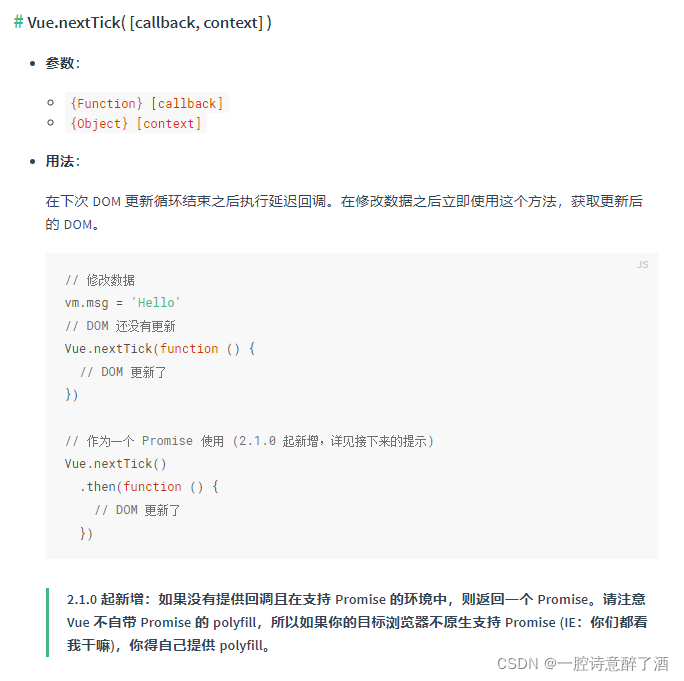文章目录
1. 入口
-
src\core\instance\index.js里面的renderMixin(Vue) -
src\core\instance\render.js里面的
export function renderMixin (Vue: Class<Component>) {
installRenderHelpers(Vue.prototype)
Vue.prototype.$nextTick = function (fn: Function) {
return nextTick(fn, this)
}
...
}
-
src\core\util\next-tick.jsexport function nextTick (cb?: Function, ctx?: Object) { let _resolve callbacks.push(() => { if (cb) { try { cb.call(ctx) } catch (e) { handleError(e, ctx, 'nextTick') } } else if (_resolve) { _resolve(ctx) } }) if (!pending) { pending = true /** * 异步函数 */ timerFunc() } // $flow-disable-line if (!cb && typeof Promise !== 'undefined') { return new Promise(resolve => { _resolve = resolve }) } }
2. nextTick执行过程
- 确定使用微任务还是宏任务,并确定
timerfunc
if (typeof Promise !== 'undefined' && isNative(Promise)) {
const p = Promise.resolve()
timerFunc = () => {
/**
* 启动微任务
*/
p.then(flushCallbacks)
if (isIOS) setTimeout(noop)
}
isUsingMicroTask = true
} else if (!isIE && typeof MutationObserver !== 'undefined' && (
isNative(MutationObserver) ||
MutationObserver.toString() === '[object MutationObserverConstructor]'
)) {
let counter = 1
const observer = new MutationObserver(flushCallbacks)
const textNode = document.createTextNode(String(counter))
observer.observe(textNode, {
characterData: true
})
timerFunc = () => {
counter = (counter + 1) % 2
textNode.data = String(counter)
}
isUsingMicroTask = true
} else if (typeof setImmediate !== 'undefined' && isNative(setImmediate)) {
timerFunc = () => {
setImmediate(flushCallbacks)
}
} else {
timerFunc = () => {
setTimeout(flushCallbacks, 0)
}
}
- 当
nextTick被调用且回调函数处于非pending时,调用TimerFuc
export function nextTick (cb?: Function, ctx?: Object) {
let _resolve
callbacks.push(() => {
if (cb) {
try {
cb.call(ctx)
} catch (e) {
handleError(e, ctx, 'nextTick')
}
} else if (_resolve) {
_resolve(ctx)
}
})
if (!pending) {
pending = true
/**
* 异步函数
*/
timerFunc()
}
// $flow-disable-line
if (!cb && typeof Promise !== 'undefined') {
return new Promise(resolve => {
_resolve = resolve
})
}
}
- func是一个微任务或者宏任务的函数,里面放着
flushCallbacks清空当前回调队列的任务
function flushCallbacks () {
pending = false
// arrayObject.slice(start,end) 返回选定元素
const copies = callbacks.slice(0)
callbacks.length = 0
for (let i = 0; i < copies.length; i++) {
copies[i]()
}
}
注意:flushCallbacks里面的copies是调用2的nextTickpush进去的,也就是我们定义的回调函数
if (cb) {
try {
cb.call(ctx)
} catch (e) {
handleError(e, ctx, 'nextTick')
}
} else if (_resolve) {
_resolve(ctx)
}
回顾一下我们使用Vue的时候怎么使用nextTick就清楚了
this.$nextTick(()=>{
console.log('hahha')
})
()=>{
console.log('hahha')
}
// 这个函数就是我们的copies啦
贴个官方的图吧

- 到这里
nextTick的原理就很清楚啦。